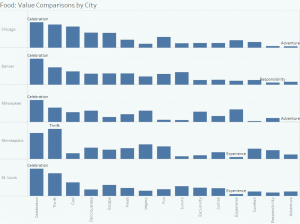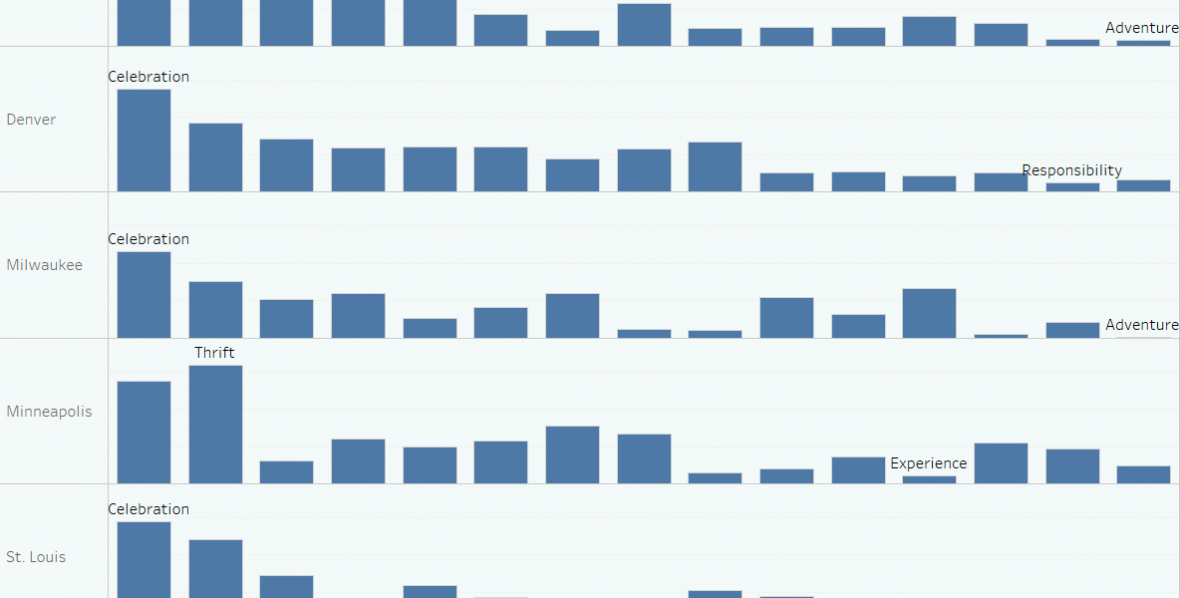What is urban character and why does it matter? What makes the character of the city of Milwaukee different than that of Denver? How do people in St. Louis compare to those in Chicago? And what are the values that give Minneapolis the flavor it has? (Does it have any flavor?)
Recently, Metametrix did a deep dive into the values of major Midwestern cities. Our goal? To use cultural analytics to understand each town’s unique character better and to see more clearly into the lives of the people who live there.
First up: We’re looking at values informing topics of food and health in five Midwestern cities — Chicago, Milwaukee, Minneapolis, Denver and St. Louis. What regional differences arise? What do those values differences mean?
FOOD CULTURE: WHILE OTHER CITIES PARTY, MINNEAPOLIS GETS THRIFTY

When we look at consumer values associated with major subcategories — like food — across cities, patterns and differences begin to illuminate each city’s unique culture.
Examining food-related values, we see common top values for all but Minneapolis. While elsewhere, people closely associate food and celebration, the most common value for Minneapolis is thrift. (Hey, we’re cheap?) A deeper dive into the data says Minneapolis also values the accessibility and affordability of farmer’s markets and supports programs that allow local produce being readily available to everyone.
Further, while other towns care plenty about the idea of cool (it’s running third or so among top values for other Midwestern cities), Minneapolis’ third-place value was legacy — showing the town’s food scene frets less about what’s hip, and has a special regard for the people who will come after. Values such as cool and celebration are more closely associated with St. Louis, Denver, Milwaukee and Chicago.
ACROSS THE REGIONS: FOUR DIFFERENT APPROACHES TO HEALTH

In looking at each of our study cities’ health values, one can see each one’s varying character simply by examining its very top values. While Milwaukee and justice are tightly linked in the realm of health, Minneapolis favors prevention; while the value of control appears when looking at Chicago. (Justice, here, pops up as a health issue because of its place in the conversation around public health and public policy.) We see also that Denver and Milwaukee show, relatively speaking, more action when it comes to justice in public health policies and programs. In contrast, Minneapolis and St. Louis show more resonance with preventive health measures.
This “prevention” value is important. It may show that Minneapolis and St. Louis are more concerned about providing services and policies that prevent “bad health” like diabetes or obesity. Minneapolis and St. Louis seem focused on the time before bad health occurs, whereas Denver and Milwaukee (and even Chicago) aim to interfere after bad health has taken hold. That’s a key difference to keep in mind when rolling out a health-focused product or service across the region.
What do differences in values mean?
While it might be simpler to assume Midwestern cities look the same (or vote the same or buy the same or act the same), regional nuances usually aren’t hard to find with a little digging into data.
For organizations concerned with consumer insights and truly understanding consumer behavior, small differences in how people in your target market prioritize values can separate success and failure.
This is the first in a two-part series examining values across Midwestern cities. Next up, we’ll look at other categories of values, including arts and culture and the outdoors.

